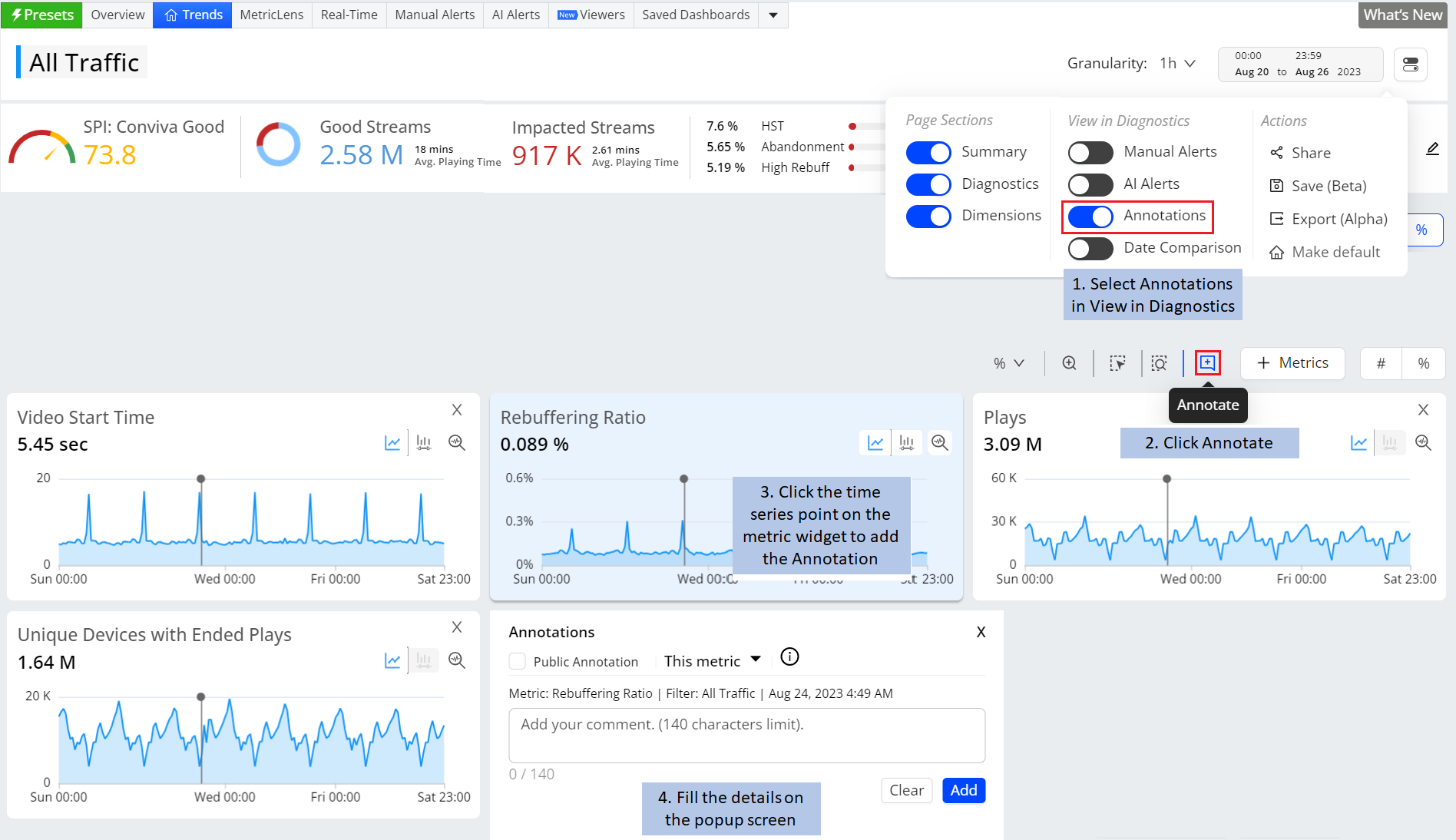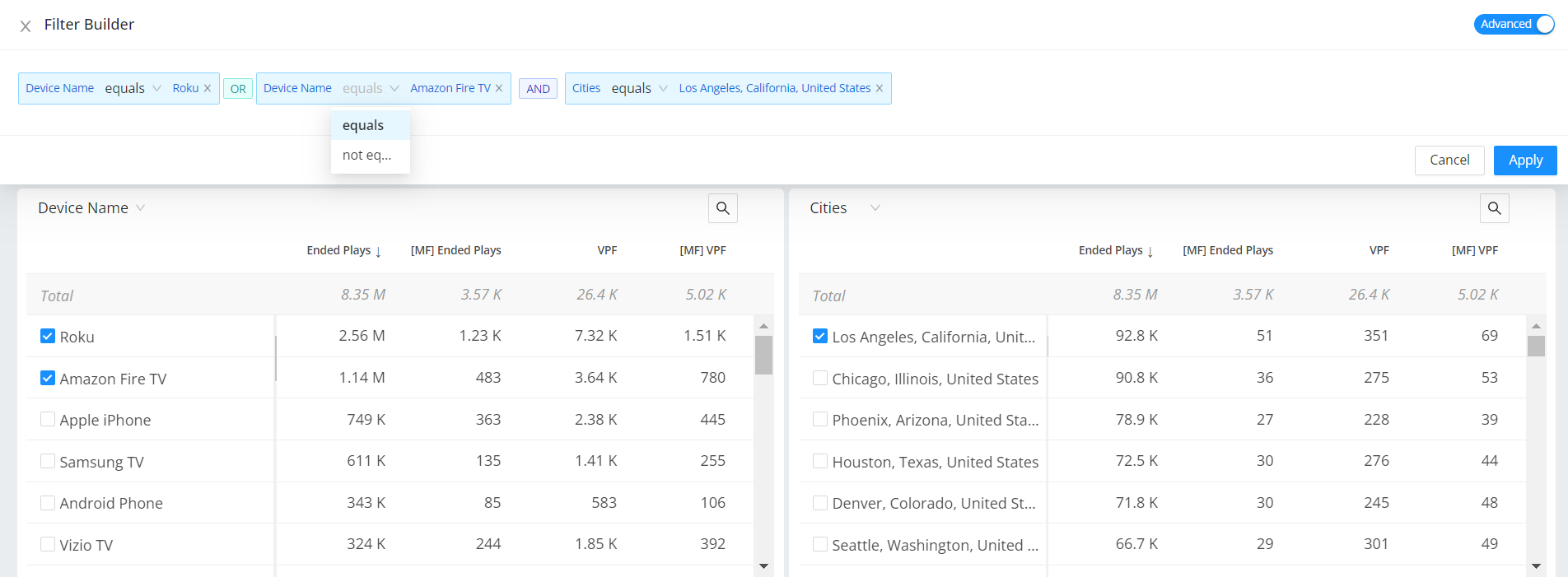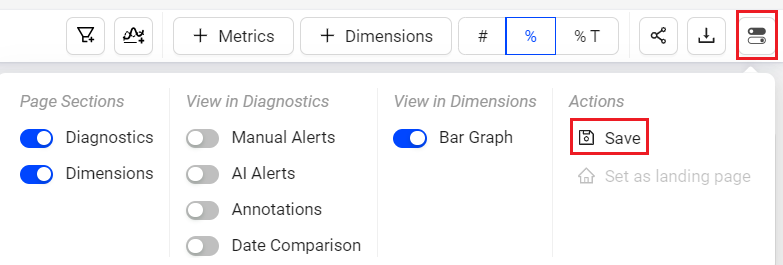Conviva Ads provides advanced diagnostic capabilities for ad creative QoE and ad engagement analysis. Powered by Conviva's high-scale, real-time, on-demand platform, Ads provides detailed time series data granularity, one-click and combinatorial instant filtering, and enhanced analysis client-side, server-side, and VPAID ads.
The key benefits are:
-
Simplified navigation and workflows for quick analysis of ad creative QoE metrics and ad engagement.
-
One-click and combinatorial instant filtering.
-
Ad metrics for easy overall analysis and correlations across ad performance and impressions:. For a list of support metrics, see Ad Metric Definitions.
-
Customizable display for client-side ads, server-side ads, or VPAID (client-side) ads.
-
Comparison percentages for summary metrics.
-
Improved metric capabilities: sorting/ordering, data latency, and granularity.
-
Enhanced date/time selection.
-
Advanced diagnostics and comparison workflows.
Interface Components | Key Enhancements | Workflow and Navigation | Filtering |Layouts| Comparisons |Webhooks| Error Code Diagnostics |
Interface Components
The Ads interface components consolidate ad creative QoE and ad engagement data into an Ads page, so you can easily gain high-level insights cross your attempted ads and also quickly deep dive into the most impactful QoE trends and anomalies, with easy navigation to advanced features such as multi-dimensional comparisons and error code analysis.
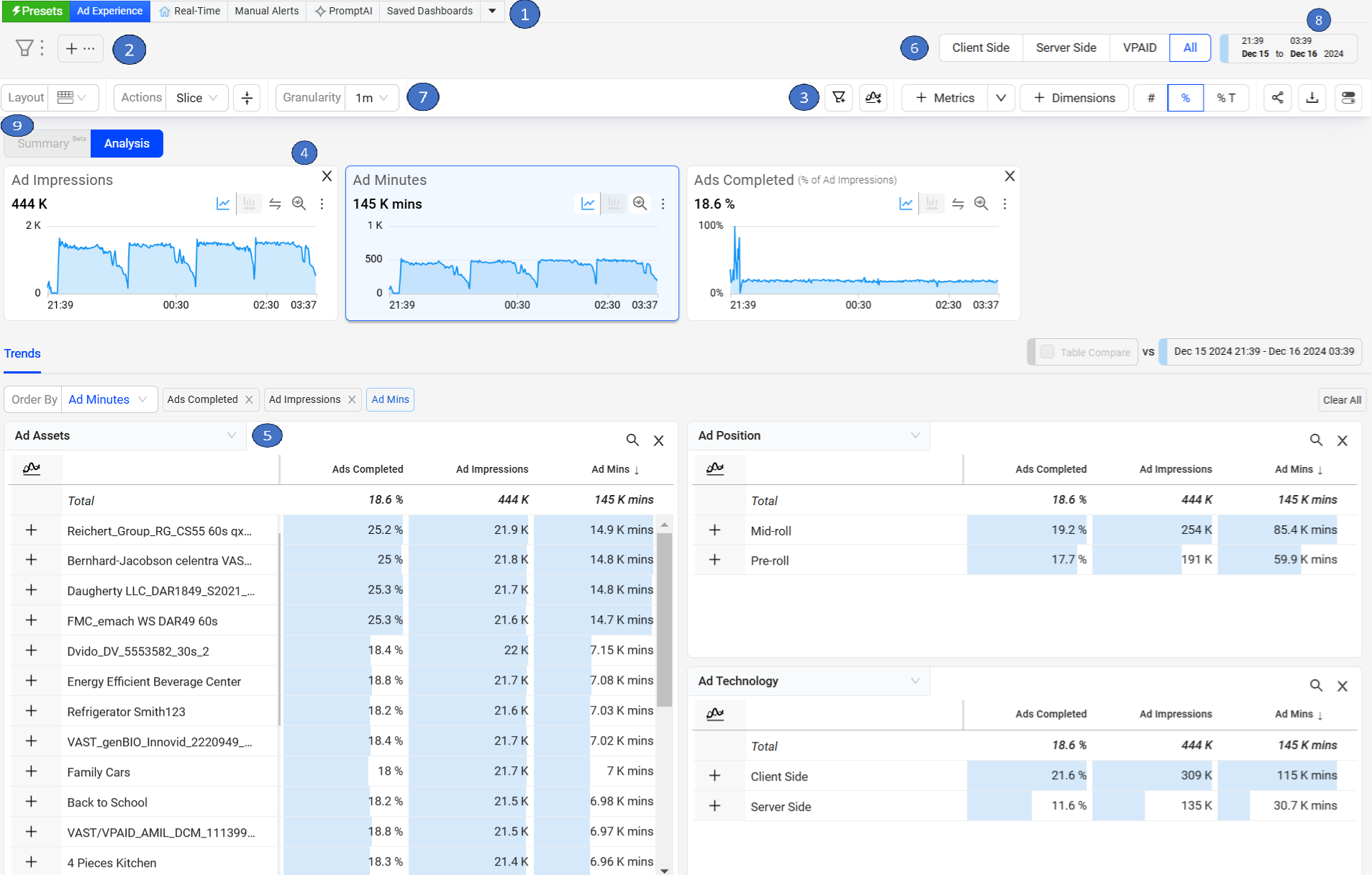
Ads tabs pane for quick page access to the default pages other saved pages. See Navigation for details.
Filter Bar to display current filter settings (All Traffic by default). Click to edit and save filters.
Action Bar for various Trends actions.
All Metric Time Series with comparative percentages and links to Diagnostics (in the future ordered by threshold impact). By default, these time series show data for the Last 6 Hour current day with 1-minute granularity.
Top Dimensions by the selected metric (in the future sorted by threshold deviation) and Order By options for advanced sorting, along with the dimension values for dynamic filtering and analysis.
Pre-defined toggles that focus on the Client Side, Server Side, and VPAID ads.
Granularity dropdown list allows you to select the time interval for detailed data analysis within a selected time interval.
Date/Time picker for customized time selection and comparison percentage setting. Save, share, export Kebab icon.
Layout to select a layout from a wide range of available layouts.
Key Enhancements
| Simplified Navigation | One-Click Instant Filters and Combinatorial Filters | Enhanced Data Capacity, Accessibility, and Granularity | Enhanced Date / Time Selection |
|---|---|---|---|
|
|
|
|
Workflow and Navigation
Ads starts with the Ads page as default landing page for easy metric and multi-dimensional drill-down analysis.
Use the Make Default option in the kebab icon to customize your default landing page to display the most relevant data, for example Real-Time for on-going ad performance and experience monitoring.
Saved/Unsaved dashboards appear as a tab next to the Ads tab. It can be accessed from the dashboard drop-down. A blue dot indicates that the dashboard is unsaved.

If needed focus your analysis on one of the pre-defined Ad Technology-based filters.

The Ads view displays the Filter bar for applying additional filter settings, summary metrics and select metric time series for metric analysis, and four dimensions with top 200 values ordered by the Order By metric for advanced drill-downs and cross-dimensional analysis.
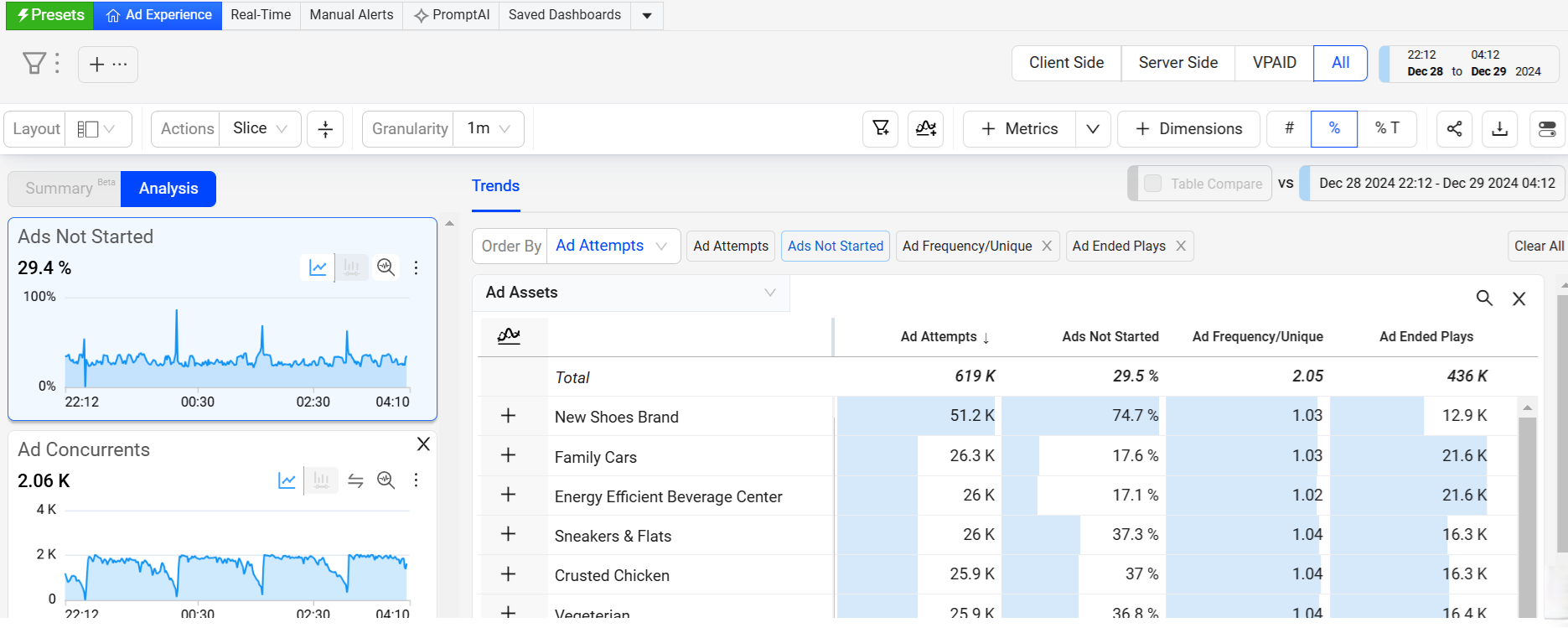
For example, selecting the Ad Impressions time series displays the top trending dimensions for ads impressions, to highlight actual ad plays.
Click other metric time series or select the Top Trends By <metric> to display dimension values for other metrics. The current metric is displayed in the Top Trends By <metric> heading.
Click the Order By <metric> to change the ordering of the dimension values by an audience metric. Up to 200 dimension values are displayed for each dimension.
Click the dimension heading to select different dimensions.
Quickly toggle between number and percentage values.
Click a metric value at the top of a dimension column to sort that dimension data as ascending or descending by that metric.
Click Metrics to add additional metrics to the Ads display.
Click Share and Export the dashboard for re-use and collaboration.

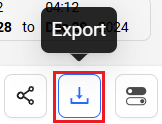
The Share Dashboard window displays options to copy or email the URL to the current dashboard. Shared dashboards +cannot be modified.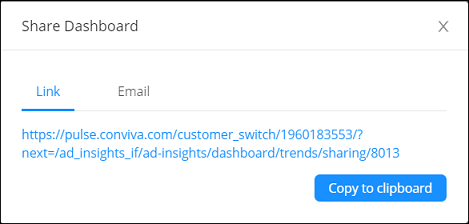
Export creates a CSV file of the dashboard data.

Presets
Trends offers pre-defined feature options as quick starting points to provide access to commonly used metrics and metadata use cases. Users can customize these pre-defined selections as needed and save them as private or public shared dashboards.

Annotations
Annotations allow you to mark the anomalies in the timeseries during the data analysis within the selected time interval in Trends dashboard and Compare. Also, it enables you to add comments making it a collaboration tool.
You can add and save the annotations in the following two levels:
Metric: Annotation is visible for selected metric across all dashboards.
Dashboard: Annotation is visible for all metrics across all dashboards.
Dynamic Y-Axis
Dynamic Y-Axis narrows the granularity of the y-axis range to focus more precisely on the displayed data points. Pulse calculates the maximum and minimum values, adds appropriate buffers, and determines whether to include the zero position in the y-axis. Excluding the zero position often improves the clarity and interpretation of scatter charts.

Diagnostics
Click Diagnostics ![]() in a metric time series to display an expanded view of the time series above the trend data.
in a metric time series to display an expanded view of the time series above the trend data. 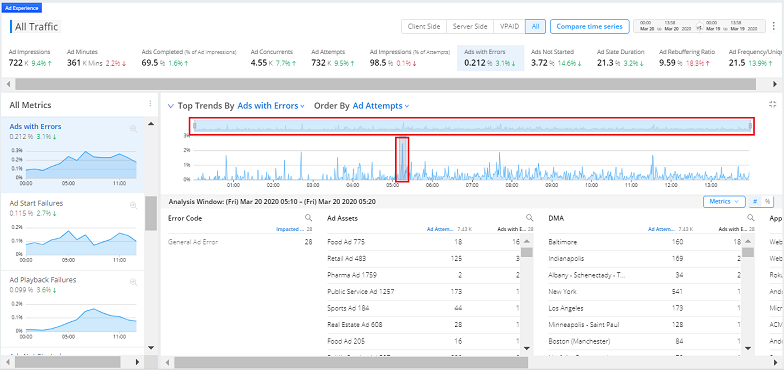
For metrics with a Order By metric, such Ad Impressions (% of Attempts) ordered by Ad Attempts, a time series of the secondary metric also appears under the main time series for comparative analysis. Changing the Order By metric also displays the selected metric in the secondary time series.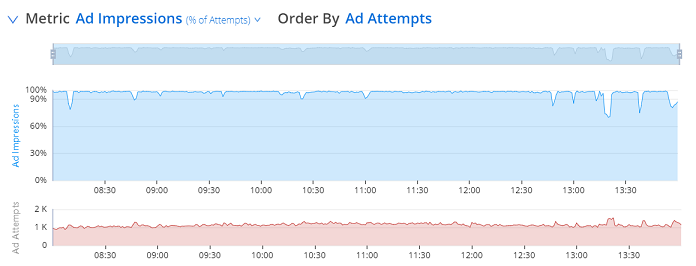
You can use the birds-eye slider above the diagnostic time series to focus the span of analysis. You can also slice a specific time period to focus the data on that period.
The data granularity for the diagnostic data is:
1-minute data granularity for any duration less than 24 hours within the past 30 days.
1-hour data granularity for any duration up to 30 days withing the previous 13 months.
Daily data granularity for any duration greater than 30 days and within the previous 13 months.
To display a different companion metric, click Metrics to expand a drop-down list of the available companion metrics.

Companion metrics apply to all the displayed dimensions and are helpful as comparative analysis, typically metrics that are behaviorally related to the primary metric or serve as a component in the calculation of the primary metric, for example, Ad Impressions and Ad Attempts.
Click the companion metric to toggle the descending and ascending sort order of the dimension values.(Previously, the companion metric was always set as Ad Attempts.
Click the kebab icon to Share and/or Export the dashboard data for re-use and collaboration.

Share displays options to copy or email a link to the current dashboard.
For more details about navigating Ads features, see Ads Navigation.
Layouts
You can select from multiple layout options to enhance your experience and customize the interface to fit your needs. These new layouts allow you to tailor the dashboard’s appearance, giving you greater flexibility to interact with data in a way that aligns with your workflow and preferences.
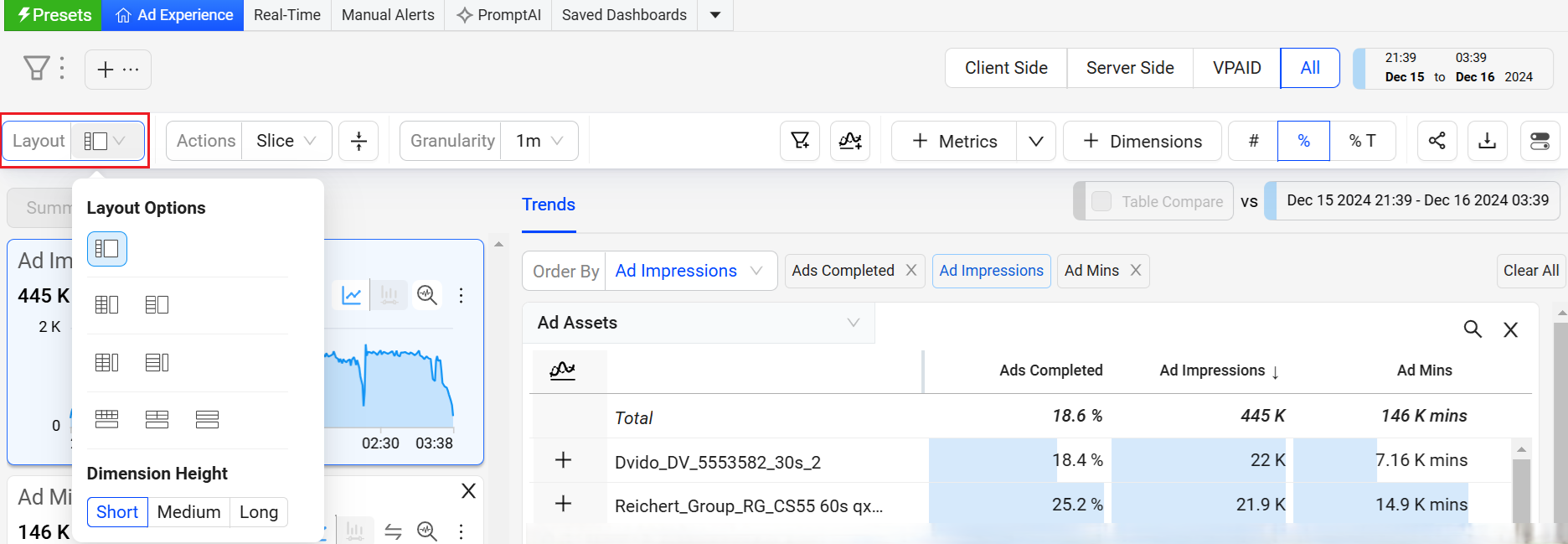
Metrics and Dimension Metrics
Metrics
To add the metrics to the Metric widgets and the dimension table,
Click the Metrics button in the action bar, to see the metrics slider.

Select the metrics from the metric slider and click Apply.
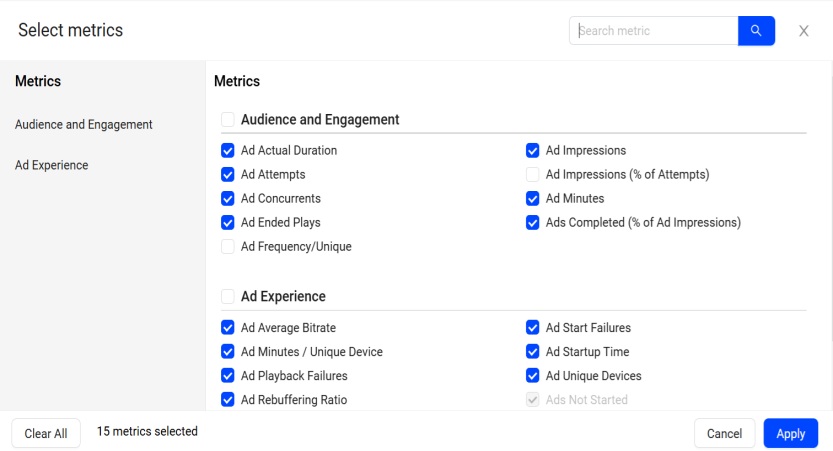
The selected metrics appears in the metric cards and the dimension table.
Dimension Metrics
To add the metrics to only the dimension table,
Click the drop-down next to Metrics button and click Dimension Metrics, to see the metrics slider.

Select the metrics from the metric slider and click Apply.

The selected metrics appears as a new column in the dimension table.
Dimensional Drill-Downs Across Metrics, Impacted Sessions, and Impacted Viewers
Dimensional Drill-Downs Across Metrics
Use dimensional drill-downs in Trends and Overview dashboards to apply instant filters for cross-dimensional root cause analysis, for example startup error codes by location and device type.
Additional secondary filters can be applied to further identify the root cause by a combination of metric settings, such as high bitrates and high rebuffering.
Up to eight dimension tables
Impacted viewer sessions
Impacted viewers
Filtering
Trends filters data with precision, offering three types and three methods for focused analysis.
The three types of filters are Main filters, Secondary filters and Compare filters.
Main Filters:
Main Filters supports four filtering methods:
Single click instant filtering: You can click the dimension data entry to apply the filter. When the filter is applied the metric widget and dimension data is updated based on the applied filter. The applied filter in visible in and you can share this filter across other users.
Filter Builder Tool Bar settings enable quick acces to save the current filter settings, open the advanced filter builder settings, updated an applied filter, and access filter settings in savedfilters, dimensions, and custom tags.
Advanded Filter builder: Trends allows you to build the filter from the Filter Builder option using the basic or advance modes, which displays on the main filter bar updating the diagnostic metric widget and dimension data.
Inline Filters: You can create, edit, and apply filters without opening the filter builder pop-up screen.
Secondary Filters: This is built on top of the data built on the main filter which is applied from the distribution view in the metric widget.
Compare Filters: You can quickly compare the filters for the top dimension entities or the custom lists of dimension filters.

Combinatorial Filters
To create a filter for a known combination of dimension values (building the filter options in the panel before applying settings), click Advance click the + symbol next to the dimension values to add the values to the combinatorial filter box. Clicking the + symbol next to additional dimension values creates complex filters based on logic OR and AND filter rules.
Logical OR filter rules apply to dimension values from dimensions that already have a value in the current filter (same dimension column).
Logical AND filter rules apply to dimension values from a new dimension, not already specified in the current filter (new dimension column).
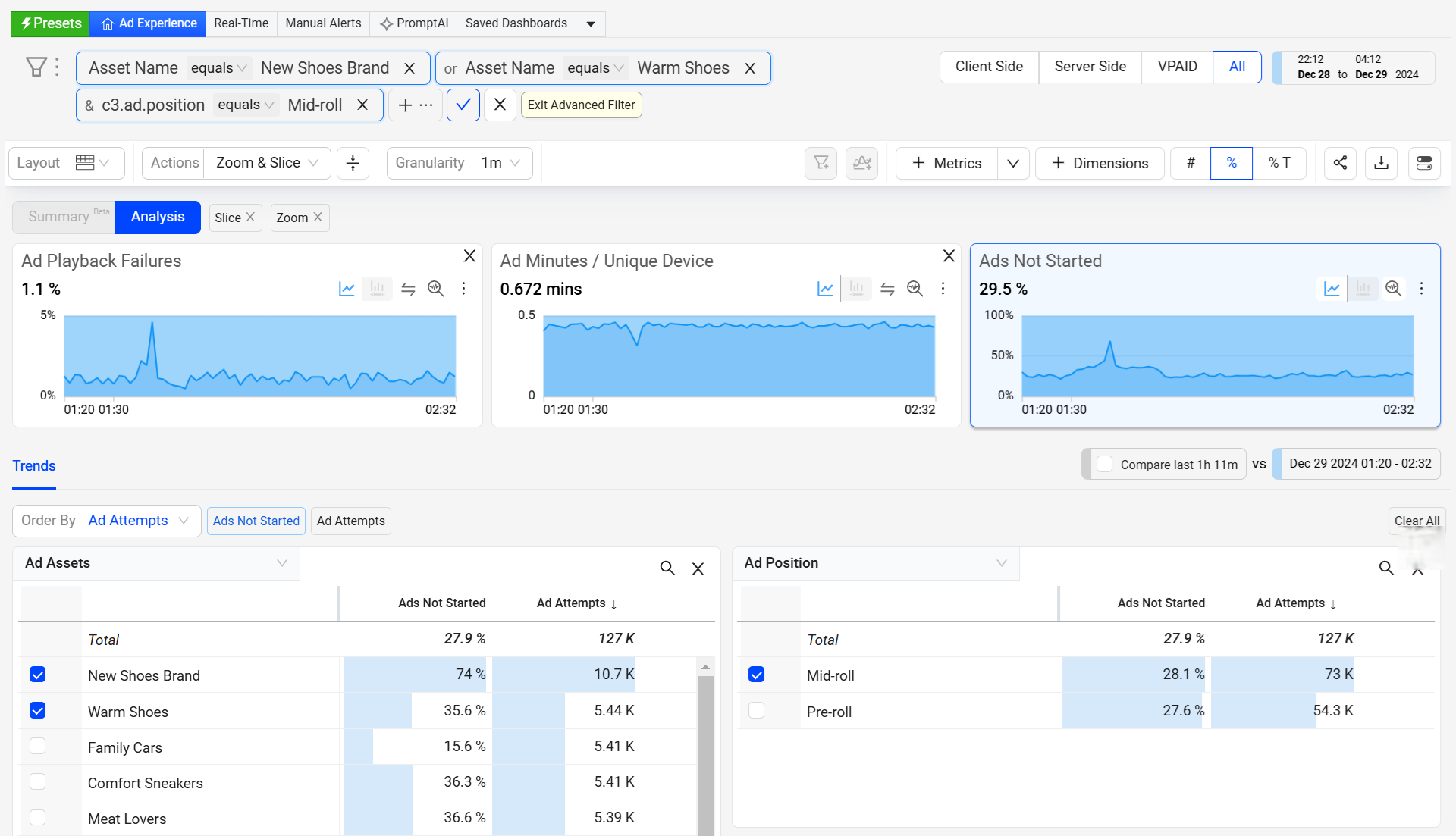
Filter Builder
Easily visualize side-by-side comparisons based on advanced filter settings, in the dimension tables with links to Trends.
After zoom, select and dimension filters, you can create the filters to see the specific data. Along with the single click filters you can create dimension filters based on equals and contains filter options.
For example, create a dimension filter for asset analysis that does not contain video trailers.
Trends allows you to create a complex filter with conditions easily. Also, you can filter the unknowns and compare the between Basic and Advance modes using the toggle.
The Advanced option allows you to easily see the conditions applied and modify the filters. This advance mode allows you to change the condition equals and not equals on the fly.
Inline Filters
Using the filter builder in Trends enables focused data analysis along with inline filter creation and updates.
Inline filter rule addition, modify operators, and directly apply the filter rule.
Save inline settings to create new filters.
Open filter builder for a full view of filter creation and management.
Open Filter Management to browse saved filters, and directly apply to Trends.
Combinatorial Filters
To create a filter for a known combination of dimension values (building the filter options in the panel before applying settings), click the + symbol next to the dimension values to add the values to the combinatorial filter box. Clicking the + symbol next to the dimension values creates complex filters based on logic OR and AND filter rules.
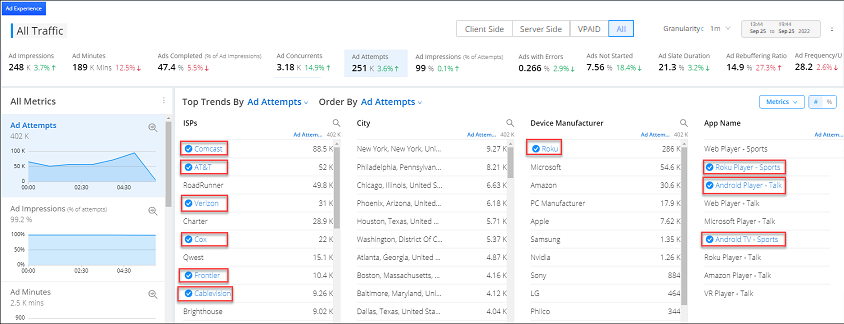
Logical OR filter rules apply to dimension values from dimensions that already have a value in the current filter (same dimension column).
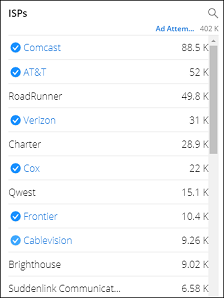

Logical AND filter rules apply to dimension values from a new dimension, not already specified in the current filter (new dimension column).


For verification, the filter values appear in the Combinatorial Filter box bar after applying them.

Ad Metrics Sorted by Video Metadata
In the dimension drop-down, you can also filter ads by video dimensions, such as country, device name, and video asset name.
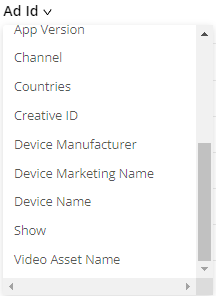
Filter Management Tasks
To perform filter management tasks, such as creating a permanent filter, resetting filter values, or modifying an existing filter, click the Filter Status bar to open the filter management page.
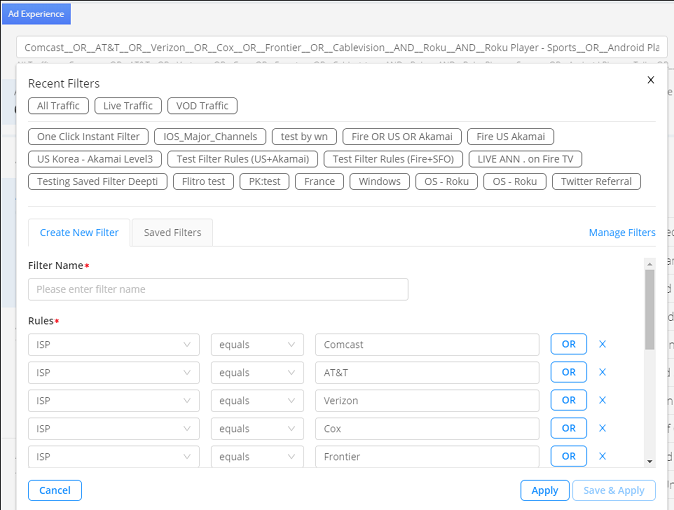
Existing filters can be modified and applied as needed. Creating and saving a new filter enables the filter to be applied to both the new and existing Ads pages.
Filter management functionality allows you to add, modify, save, and apply filter settings.
Click the Kebab ![]() to share the dashboard for re-use and collaboration. Shared dashboards cannot be modified.
to share the dashboard for re-use and collaboration. Shared dashboards cannot be modified.

Data Granularity and Time Intervals
With Ads, audience and performance metrics are displayed for easy in-depth analysis and correlation. The metrics data and time series widgets display metric data with enhanced time period and granularity, down to 1-minute data intervals for up to 24 hours within the last 30 days.
Data Granularity
In addition to the enhanced time-picker selection, data granularity improvements support 1-minute data granularity for any 24-hour period within the last 30 days and hourly data for up to 13 months.
Previous Data Granularity | New Data Granularity |
|---|---|
1-minute data intervals up to 6 hours. | 1-minute data intervals up to 24 hours, within the last 30 days. |
Hourly data intervals from 1 day to 7 days. | Hourly data intervals up to 30 days within the last 13 months. |
Daily data intervals from 7 days to 30 days. | Daily data intervals for greater than 30 days within the last 13 months. |
Data Accessibility
Using Ads, including the Diagnostics pages, metric data appears within 10 minutes or less for timely impact analysis.
Enhanced Ad Impressions (% of Attempts) and Ad Attempts Analysis
To enhance the effectiveness of ad impression and attempted ad Analysis, Ads includes the Ad Impressions (% of Ad Attempts) metric. With this metric, ad impressions can be more clearly analyzed along with the percentage of all attempted ads associated with specific dimensions. The Ad Impressions metric now shows the number and percentage of all ad impressions associated with specific dimensions.
Analyzing the number and percentage of actual ad impressions alongside the attempted ads enables more detailed insights into which dimensions, such as ad server, players and ad creatives, were most impacted by delivery and performance issues that led to both successful and unsuccessful ad attempts.
For example, click the Ad Impressions metric in the summary list to change the Top Trends By and Order By metric to Ad Concurrent Plays. The Top Trends By metric determines the set of data to display for each dimension. The Order By Metric enables you to sort that data by different metric values.
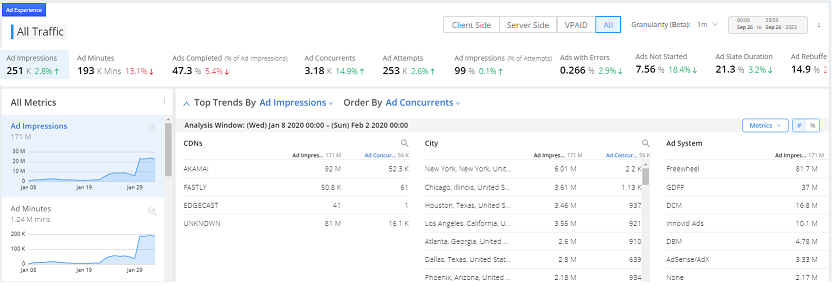
When displaying multiple metrics, you can also click any of the highlighted metric names above the dimension values to sort the dimension values in ascending or descending order by that metric. For example, click the Plays metric to change the order the dimension values from Attempts to the number or percentage of Plays, in ascending or descending order.

Date and Time Intervals
Ads provides pre-defined time intervals along with a calendar based time-picker for custom intervals. The time-picker also supports a specific hour, and 5-minute ranges from 00:00 hour to 23:59 hour.

Click Time Frame settings and select a predefined range or use the time selector to choose the start and end dates/times for the desired time interval.
Time Granularity
The Trends page, including Diagnostics and Compare, supports enhanced granularity levels, such as:
1 min, 5 min, 15 min, and 30 mins for 1-hour intervals
1 hour, 6 hours, 12 hours, 1 day, and 7 days for 30-day intervals
Share, Save and Export
Share
Share snapshots of dashboards and widgets with other Ads users by clicking Share in the toggle menu. Sharing is supported in Trends, Overview, MetricLens, Real-Time, Compare, and Viewers dashboards.
When you click on the Share button, Ads saves a snapshot of the item for the last 30 days and produces a link that you can share by email, by Slack message, or by pasting it into another document.
When a user opens the link and logs in to Conviva Ads, they see an exact copy of the item you sent. They can change how Ads presents the data in the snapshot, but cannot change which data are part of the snapshot. For example, the user can deselect metrics to hide them, but they can't change the dimension or time series.
Save
Saving shared dashboards is supported in Overview, Trends, MetricLens, Real-Time, Compare, and Viewers dashboards. Save the dashboard for re-use and collaboration with the other users who have access to the account.
The saved dashboards appears in the Saved Dashboard tab.
In the Saved Dashboards tab,
My Dashboards displays the private saved boards, which is visible only to the owners.
You can edit the data after the dashboard has been saved.
Public Dashboards displays the public saved boards, which is visible to all users.
For more information on save, share and delete the public saved dashboards, see Public Saved Dashboard.
Note: The blue dot indicates that the dashboard is unsaved.
Export
Depending on your analysis needs, you might want to export the data from a dashboard or other page for use elsewhere. It's easy to do: just click Export in the kebab menu. The resulting file is a comma-separated text file that you can import into a spreadsheet or other analytical application.
Note: If the dimension table contains a blank column, the system excludes the blank columns during export.

Comparisons
The enhanced comparison feature provides simplified comparisons of metric performance across the current time series or up to 20 saved filter settings.
Time Series Comparisons
Time Series comparisons enable you to select metrics and dimension values for comparative analysis in a separate dashboard. Because the metric and dimension values are determined by the current filter settings, make sure the current filter settings, such as All Traffic, Live, or VOD, apply to the intended data set for time series comparisons.
Click the Compare button to enter Compare mode.
In Compare mode, radio buttons appear next to the dimension names and values so they can be easily selected for the comparison. Other metrics can be added in the Compare view.
There are several ways to build and customize filters for comparisons. Up to 20 dimension values can be applied:
Click a dimension name to create filters for the top 10 dimension values. The selected values appear in the filter panel.
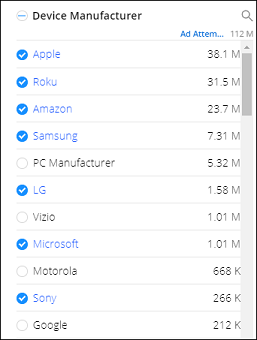

Click dimension values in different dimension columns to build logical AND/OR filter rules (Comcast AND Roku AND New York).


Click dimension values in the same column to build logical OR filter rules (Roku OR Amazon Fire TV OR Apple iPhone).
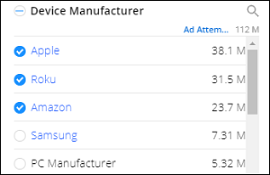

The Filter bar populates with the specified filters and filter settings, along with filter options - Highlighting indicates the current filter for editing. Plus-sign adds another filter to the filter panel. An 'X' icon removes the filter.

After the filter settings are selected and appear in the filter panel, click the Compare button in the bottom filter bar to view the comparison data in the Comparison dashboard. When viewing the data, click Modify Comparison to change the metric and filter settings.
Click Kebab to Share and Export the dashboard for re-use and collaboration. Shared dashboards cannot be modified.

Compare Using Saved Filters
In Compare mode, you can also select a saved filter, such as Live Traffic and VOD Traffic, to add that data to a comparison.

Note: After clicking the Compare time series button, you need to enter Compare mode before additional filters can be created and applied.
To access saved filters in Compare mode, click the filter bar and in the Saved Filters tab select the desired filters. The data associated with the selected filters appears in the Compare view. This example compares traffic for VOD, Live, and Amazon Fire TV.
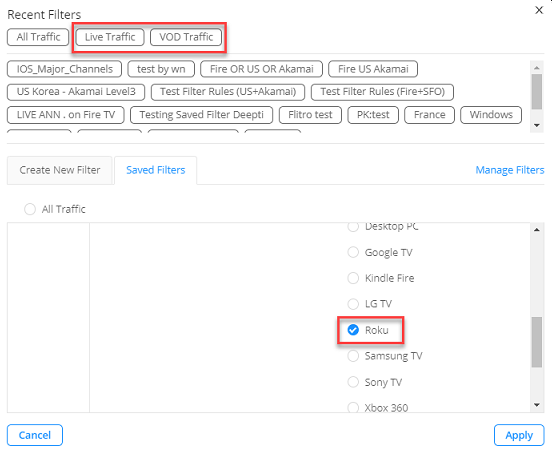
Comparison Use Case
This use case demonstrates a common scenario using comparison filtering to isolate metric anomalies across multiple dimensions.
This scenario sets filters to compare Ad Attempts across two operating systems in multiple cities to analysis and isolate ad attempts to a specific operating system.

Select Roku OS as the operating system in the Device Operating system column, and select a city. Repeat this for iOS and select a city.

Click Compare in the bottom Filter bar to view the comparison time series. In the Comparison dashboard, note the spike in Ad Attempts on version 9.2 on Roku OS in the New York area.

Click the Kebab to Share and Export the dashboard for re-use and collaboration. Shared dashboards cannot be modified.

Ad Webhooks
Ad Webhooks enable automated notifications to external systems when a manual or AI alert fires within Conviva. These Webhooks push alert information through HTTP POST requests to a destination webhook URL that is a destination endpoint on your server.
You can use these webhooks to integrate Conviva alert events into external applications, such as displaying Conviva alerts in an alert aggregation system or triggering workflows in other applications, such as JIRA or other support ticket applications.
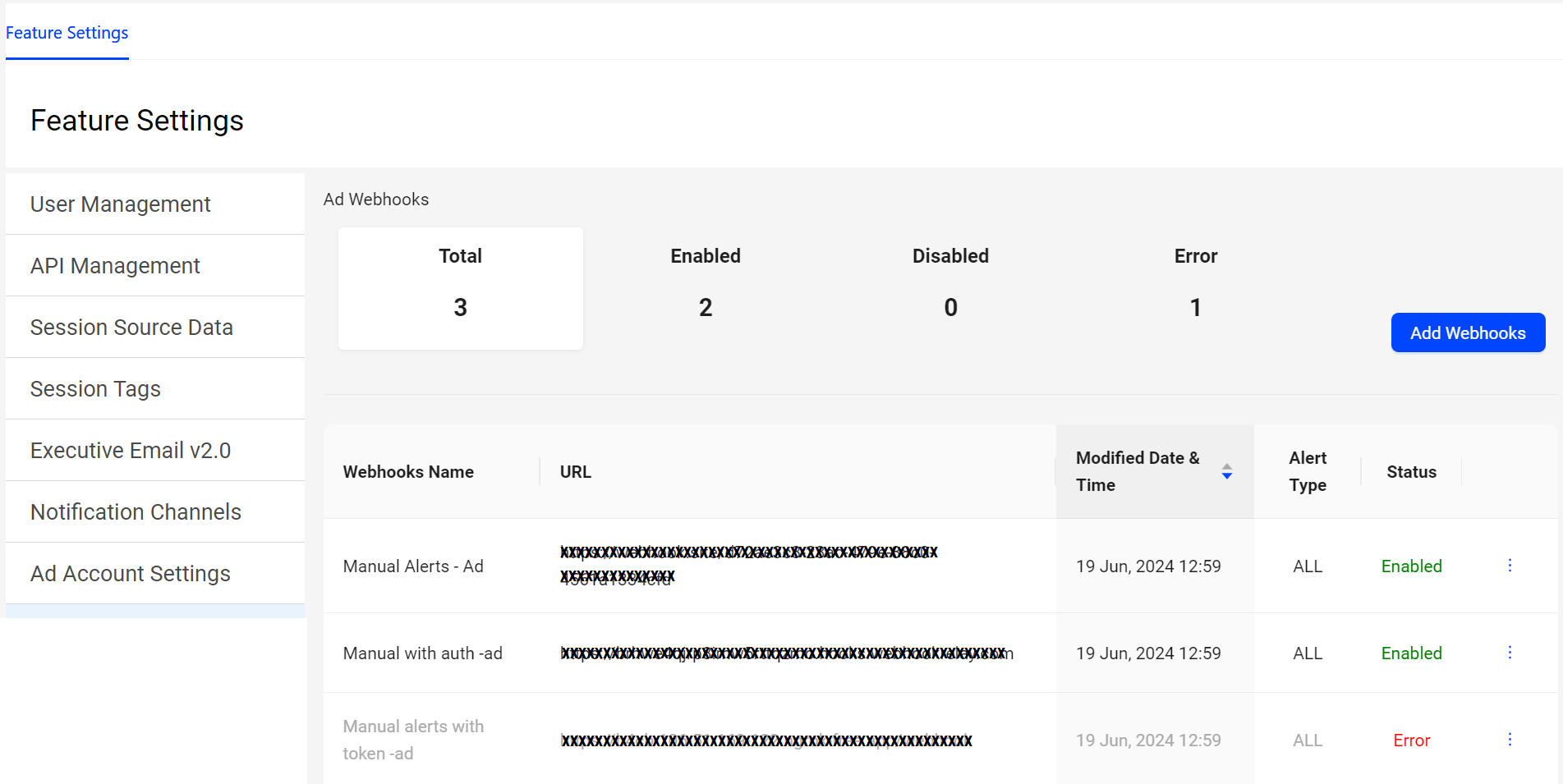
For more information on configuring webhooks, see Ad Webhooks.
Error Code Diagnostics
The Ads view provides a detailed analysis of error codes for consolidated for Ad Start Failure (ASF) and Ad Playback Failure (APF) metrics. Error codes are consolidated across these metrics for simplified analysis.
To drill into the behavior and performance related to an error code, click the ASF or APF metric in the Metric list.

The error codes appear in the Error Code column.
To analyze the causes of the errors, click an error code with a high number of impacted devices to view detailed analytical data.
The analysis page appears with a time series for the error tracking and total vs. impacted time series for the secondary metric, in this case Ad Attempts.
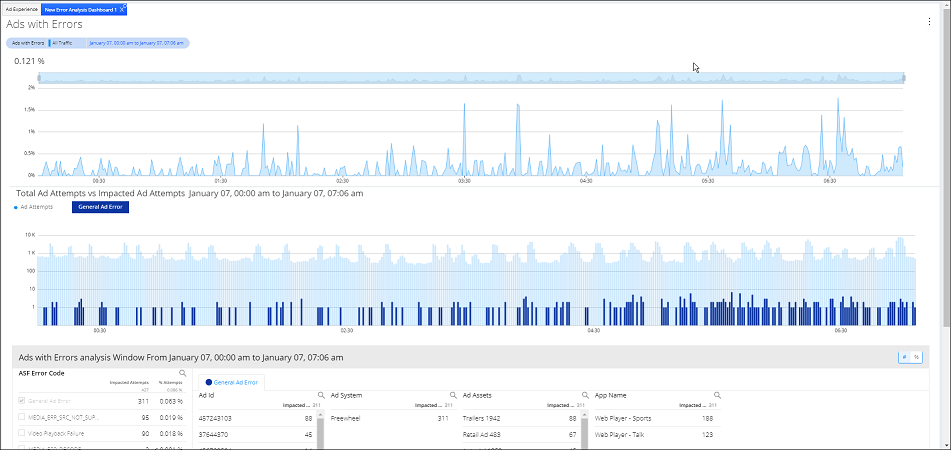
Note: Secondary metric data is displayed as a logarithmic scale, so both Ad Attempts and ASF data can be displayed on the same chart.
In addition, dimension and dimension values enable detailed performance analysis.
In the error code time series, select a time range related to an anomaly, such as a spike in ASF errors. The secondary metric and dimension data update to reflect the selected time range.
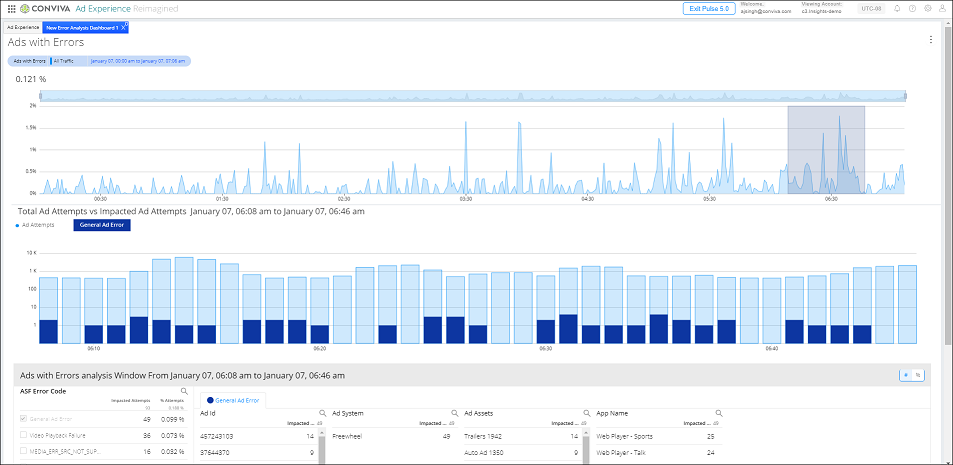

Additional error codes can be selected to further analyze the impact of multiple errors.
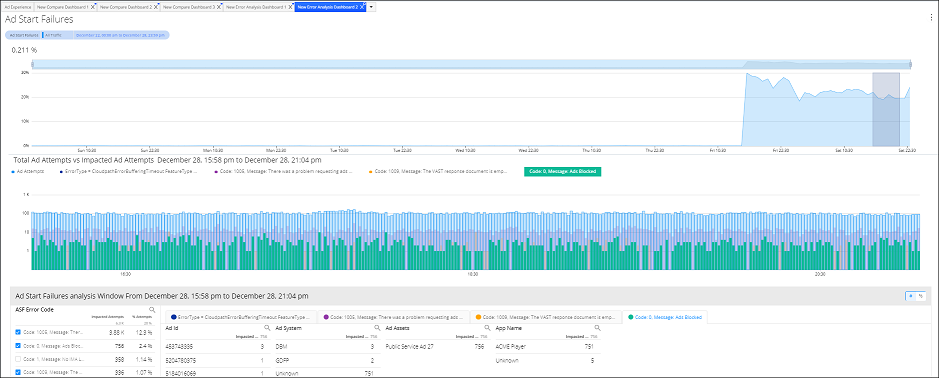
Clicking an error code highlights the impact of the error in the secondary metric time series and dimension values.
While several error codes may appear simultaneously, typically one error code will be most impacting of specific spikes in ASF and APF errors.
Click Kebab to Share and Export the dashboard for re-use and collaboration. Shared dashboards cannot be modified.

For Ads use cases, see Ads Use Cases.
